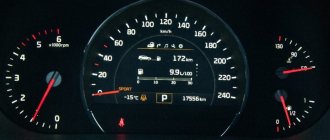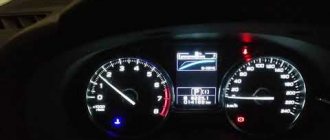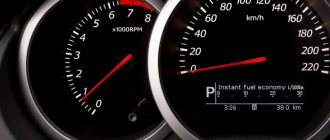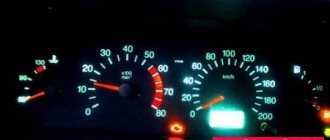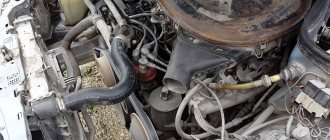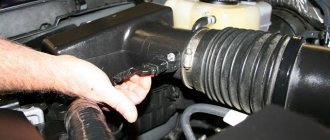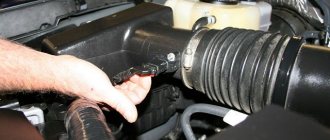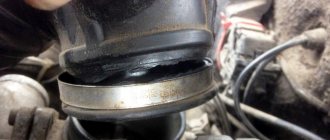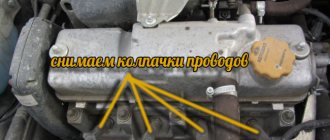The operating mode of the engine is one of the main factors influencing the wear rate of its parts. It’s good when the car is equipped with an automatic transmission or a variator, which independently selects the moment of transition to a higher or lower gear. On cars with “mechanics”, switching is done by the driver, who “spins” the engine according to his own understanding and not always correctly. Therefore, car enthusiasts without experience should study what speeds are best to drive at in order to maximize the life of the power unit.
Driving at low speeds with early shifting
Often, driving school instructors and old drivers recommend that beginners drive “tight” - switch to higher gear when the crankshaft reaches 1500–2000 rpm. The former give advice for safety reasons, the latter out of habit, because previously the cars had low-speed engines. Nowadays, such a mode is only suitable for a diesel engine, whose maximum torque is in a wider speed range than that of a gasoline engine.
Not all cars are equipped with tachometers, so inexperienced drivers with this driving style should be guided by driving speed. The early switching mode looks like this: 1st gear - moving from a standstill, transition to II - 10 km/h, III - 30 km/h, IV - 40 km/h, V - 50 km/h.
Such a switching algorithm is a sign of a very calm driving style, which gives an undoubted advantage in safety. The downside is the increased wear rate of power unit parts and here’s why:
- The oil pump reaches its rated output from 2500 rpm. The load at 1500–1800 rpm causes oil starvation, especially the connecting rod bearings (liners) and compression piston rings are affected.
- The combustion conditions of the air-fuel mixture are far from favorable. Carbon deposits are heavily deposited in the chambers, on valve plates and piston heads. During operation, this soot heats up and ignites the fuel without a spark at the spark plug (detonation effect).
- If you need to sharply increase engine speed when driving at the very bottom, you press the accelerator, but acceleration remains sluggish until the engine reaches its torque. But as soon as this happens, you engage a higher gear and the crankshaft speed drops again. The load is large, there is not enough lubrication, the pump pumps antifreeze poorly, which causes overheating.
- Contrary to popular belief, there is no gas savings in this mode. When you press the gas pedal, the fuel mixture becomes richer, but does not burn completely, which means it is wasted.
Owners of cars equipped with an on-board computer can easily convince themselves of the uneconomical nature of driving under tension. It is enough to turn on the display to show instantaneous fuel consumption.
This type of driving greatly wears out the power unit when the car is operated in difficult conditions - on dirt and country roads, with a full load or a trailer. Owners of cars with powerful engines of 3 liters or more, capable of sharp acceleration from the bottom, should not relax either. After all, to intensively lubricate the rubbing parts of the engine, you need to keep the crankshaft at least 2000 rpm.
Engine life and speed when driving
Let's start with the fact that competent operation and constant maintenance of optimal engine speeds allows you to achieve an increase in engine life. In other words, there are operating modes when the motor wears out the least. As already mentioned, the service life of the internal combustion engine depends on the driving style, that is, the driver himself can conditionally “adjust” this parameter. Please note that this topic is the subject of discussion and debate. More specifically, drivers are divided into three main groups:
- The first include those who operate the engine at low speeds, constantly moving “pull”.
- The second category includes drivers who only periodically rev up their engine to above-average speeds;
- The third group is considered to be car owners who constantly maintain the power unit in a mode above medium and high engine speeds, often driving the tachometer needle into the red zone.
Driving at low speeds
Let's take a closer look. Let's start with driving at the "bottoms". This mode means that the driver does not raise the crankshaft speed above 2.5 thousand rpm. on gasoline engines and holds about 1100-1200 rpm. on diesel. This driving style has been imposed on many since driving school. Instructors authoritatively assert that it is necessary to drive at the lowest speeds, since in this mode the greatest fuel economy is achieved, the engine is least loaded, etc.
Note that during driving courses it is advised not to turn the unit, since one of the main tasks is maximum safety. It is quite logical that low speeds in this case are inextricably linked with driving at low speeds. There is logic in this, since slow and measured movement allows you to quickly learn how to drive without jerking when changing gears in cars with a manual transmission, teaches a novice driver to drive in a calm and smooth manner, provides more confident control over the car, etc.
Obviously, after receiving a driver’s license, this driving style is then actively practiced in one’s own car, developing into a habit. Drivers of this type begin to get nervous when the sound of a revving engine begins to be heard in the cabin. It seems to them that increased noise means a significant increase in the load on the internal combustion engine.
As for the engine itself and its service life, too “gentle” operation does not add to its service life. Moreover, everything happens exactly the opposite. Let’s imagine a situation when a car is moving at a speed of 60 km/h in 4th gear on smooth asphalt, the revolutions, say, are around 2 thousand. In this mode, the engine is almost inaudible even in budget cars, fuel is consumed minimally. At the same time, there are two main disadvantages in such a ride:
- There is almost no possibility of sharp acceleration without switching to a lower gear, especially with naturally aspirated engines.
- after changing the road terrain, for example, on inclines, the driver does not switch to a lower gear. Instead of shifting, he simply presses the gas pedal harder.
In the first case, the motor is often located outside the torque plateau, which does not allow you to quickly accelerate the car when necessary. As a result, this driving style affects overall traffic safety. The second point directly affects the engine. First of all, driving at low speeds under load with the gas pedal pressed hard leads to engine detonation. This detonation literally breaks the power unit from the inside.
We also recommend reading the article about what engine detonation is. From this article you will learn about the causes and consequences of engine detonation.
As for consumption, savings are almost completely absent, since pressing the gas pedal harder in higher gears under load causes the fuel-air mixture to become richer. As a result, fuel consumption increases.
Also, driving “pull” increases engine wear even in the absence of detonation. The fact is that at low speeds the loaded rubbing parts of the engine are not sufficiently lubricated. The reason is the dependence of the performance of the oil pump and the pressure of the engine oil it creates in the lubrication system on the same engine speed. In other words, plain bearings are designed to operate under hydrodynamic lubrication conditions. This mode involves supplying oil under pressure into the gaps between the liners and the shaft. This creates the necessary oil film, which prevents wear of the associated elements. The effectiveness of hydrodynamic lubrication is directly dependent on engine speed, that is, the higher the speed, the higher the oil pressure. It turns out that with a heavy load on the engine, taking into account the low speed, there is a high risk of severe wear and breakage of the liners.
Another argument against driving at low speeds is increased coking of the engine. In simple words, as the speed increases, the load on the internal combustion engine increases and the temperature in the cylinders increases significantly. As a result, part of the carbon deposits simply burns out, which does not happen with constant use at “lower” levels.
High engine speed
Well, you say, the answer is obvious. The engine needs to be revved up more strongly, as the car will confidently respond to the gas pedal, it will be easy to overtake, the engine will be cleaned, fuel consumption will not increase so much, etc. This is true, but only partly. The fact is that constant driving at high speeds also has its disadvantages.
High revolutions can be considered those that exceed an approximate figure of about 70% of the total number available for a gasoline engine. With a diesel engine, the situation is slightly different, since units of this type are initially less revving, but have a higher torque. It turns out that high speeds for engines of this type can be considered those that are behind the diesel torque “shelf”.
Now about the engine life with this driving style. Strong engine spin means that the load on all its parts and lubrication system increases significantly. The temperature also increases, further loading the cooling system. As a result, engine wear increases and the risk of engine overheating increases.
It should also be taken into account that at high speeds the requirements for the quality of engine oil increase. The lubricant must provide reliable protection, that is, meet the declared characteristics of viscosity, oil film stability, etc.
Ignoring this statement leads to the fact that the lubrication system channels may become clogged during constant driving at high speeds. This happens especially often when using cheap semi-synthetic or mineral oil. The fact is that many drivers change the oil not earlier, but strictly according to the regulations or even later. As a result, the liners are destroyed, disrupting the operation of the crankshaft, camshaft and other loaded elements.
Why is high crankshaft rotation speed harmful?
The “slipper to the floor” driving style implies constant spinning of the crankshaft up to 5–8 thousand revolutions per minute and late shifting of gears, when the noise of the engine literally rings in your ears. What are the consequences of this driving style, besides creating emergency situations on the road:
- all components and assemblies of the car, and not just the engine, experience maximum loads during their service life, which reduces the total resource by 15–20%;
- due to the intense heating of the engine, the slightest failure of the cooling system leads to major repairs due to overheating;
- exhaust pipes burn out much faster, and with them an expensive catalyst;
- transmission elements wear out quickly;
- Since the crankshaft rotation speed exceeds normal speed by almost twice, fuel consumption also increases by 2 times.
Running a car “to break” has an additional negative effect associated with the quality of the road surface. Driving at high speed on uneven roads literally kills suspension elements, and in the shortest possible time. It is enough to fly your wheel into a deep pothole and the front strut will bend or crack.
The general technical condition of the car, including its engine, cooling system, transmission and much more, can always be checked using a personal ODB-II auto scanner. One of the best representatives of this type of device is the Korean-made scanner Scan Tool Pro Black Edition.
In addition to accurate diagnostics of all components and assemblies of the car, the auto scanner is capable of displaying revolutions, oil pressure, readings from all sensors, etc. in real time. The scanner is compatible with most cars with an ODB-II connector and is quite easy to use. Information about the condition of your car can always be displayed on any device running iOS, Android or Windows.
What speed should be on a cold engine?
When the ShPG reaches operating temperature, the engine goes to idle speed (600-800 rpm) - this is the optimal speed for a stationary vehicle. The engine runs in light mode, just to avoid stalling and ensure minimal fuel consumption.
Interesting materials:
What is included in floristry? What does the Gospel include? What does the state border regime include? What does website creation include? What tastes better, halibut or flounder? What is tastier than sardine or saury? What instead of a periscope? What flows into the Baltic Sea? What is more harmful than cigarettes or alcohol? What is more profitable: pizza or 1 large?
How to ride correctly?
If you are not a race car driver or a fan of hard driving, who find it difficult to relearn and change your driving style, then to save the power unit and the car as a whole, try to keep the engine operating speed in the range of 2000–4500 rpm. What bonuses will you receive:
- The mileage before engine overhaul will increase (the full service life depends on the brand of car and engine power).
- Thanks to the combustion of the air-fuel mixture in optimal mode, you can save fuel.
- Fast acceleration is available at any time, you just need to press the accelerator pedal. If the revs are not enough, immediately shift to a lower gear. Repeat the same steps when moving uphill.
- The cooling system will function in operating mode and will protect the power unit from overheating.
- Accordingly, suspension and transmission elements will last longer.
Recommendation. On most modern cars equipped with high-speed gasoline engines, it is better to change gears when the threshold of 3000 ± 200 rpm is reached. This also applies to the transition from high to low speed.
As mentioned above, car dashboards do not always have tachometers. For drivers with little driving experience, this is a problem, since the crankshaft rotation speed is unknown, and a beginner cannot navigate by sound. There are 2 options for solving the issue: buy and install an electronic tachometer on the dashboard, or use a table that shows the optimal engine speed in relation to the speed in different gears.
| 5-speed gearbox position | 1 | 2 | 3 | 4 | 5 |
| Optimal crankshaft rotation speed, rpm | 3200–4000 | 3500–4000 | not less than 3000 | > 2700 | > 2500 |
| Approximate vehicle speed, km/h | 0–20 | 20–40 | 40–70 | 70–90 | more than 90 |
Note. Considering that different brands and modifications of cars have different speeds and revolutions, the table shows average indicators.
A few words about coasting down a mountain or after acceleration. Any fuel supply system has a forced idle mode, which is activated under certain conditions: the car is coasting, one of the gears is engaged, and the crankshaft speed does not fall below 1700 rpm. When the mode is activated, the supply of gasoline to the cylinders is blocked. So you can safely brake the engine at high speed without fear of wasting fuel.
Optimal mode
However, by 1500 rpm the pump manages to reach its design capacity, pumps lubricating fluid, and wear drops to almost zero. Already at 1800 rpm. all friction units “float” onto oil films, direct contact between the surfaces of the parts disappears, and the wear rate goes to zero. The optimal operating mode of the motor begins.
The production of parts is already so small that it is not recorded by existing instruments. The ideal range of engine operation is from 2000 to 4000 rpm. This is where the maximum torque occurs.
Verdict for the motor. What does the expression “turn up the engine” mean? More details
Why does the tachometer needle float?
It is often punctured during operation. If the tachometer needle
jumps, then the reason may be a violation of the integrity of the ignition system circuit.
It needs to be checked and the fault corrected. ... If the needle
jumps at high speeds, then the reason is the failure of the switch, which needs to be replaced.
Interesting materials:
What is Borodina's daughter's name? How to harvest cauliflower? How to remove an admin in Viber? How to remove an administrator in Telegram? How to remove iCloud from iPhone 5s? How to remove Google account from device? How to remove automatic caps on iPhone? How to remove automatic caps on Android? How to remove autofill in contact? How to remove autocomplete in Odnoklassniki?
